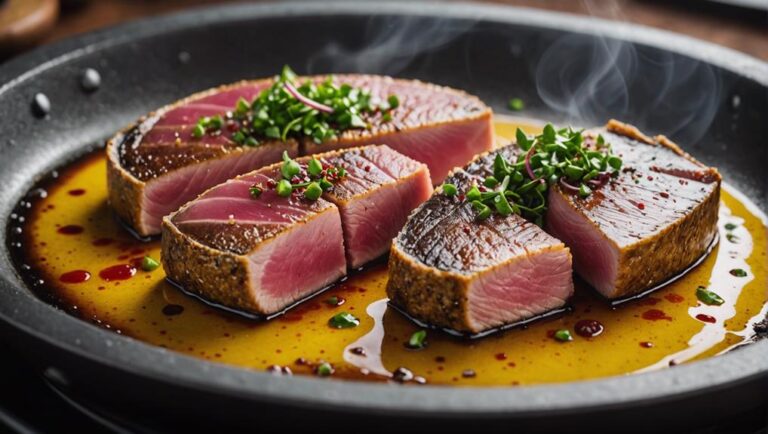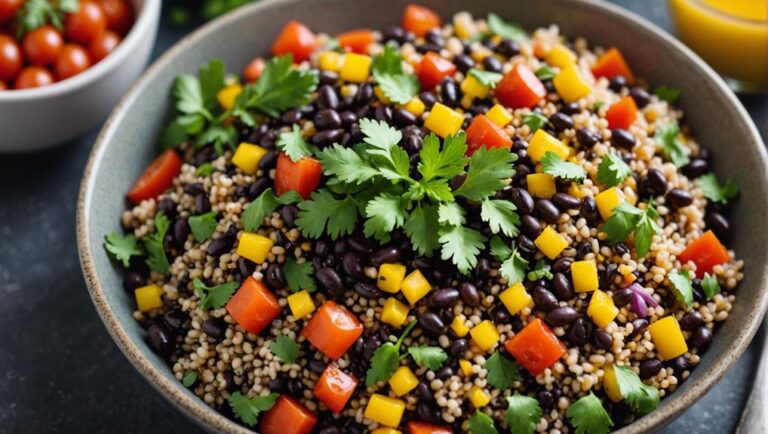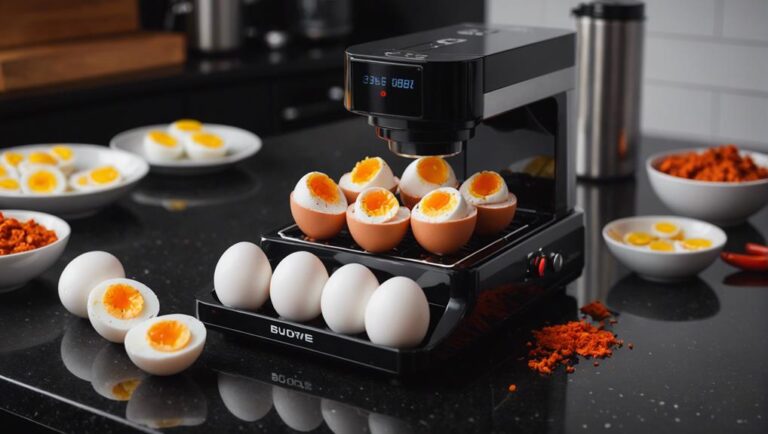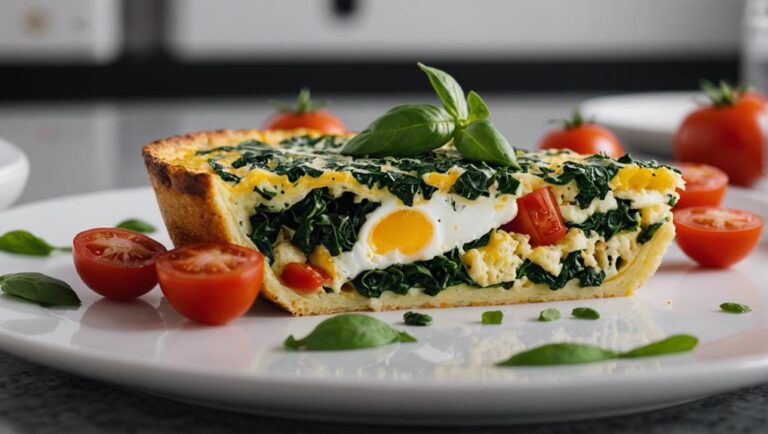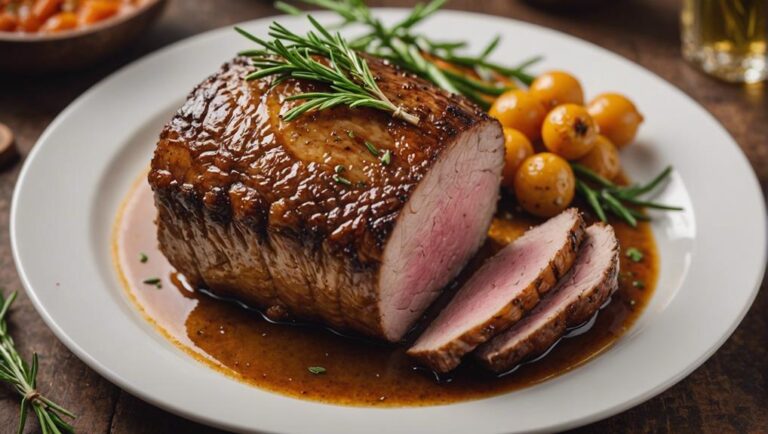Transforming Wellness: the Body for Life Diet Enhanced With Sous Vide Cooking
Elevate your wellness journey with sous-vide cooking to enhance the renowned Body for Life diet. Sous-vide involves vacuum-sealing food and precise water bath cooking, preserving flavors and nutrients while ensuring even doneness. This method is perfect for meats, veggies, poultry, fish, and eggs, supporting your wellness goals. By combining sous-vide with the Body for Life principles of balanced meals and regular exercise, you optimize nutritional quality, flavor, and tenderness. Managing meal prep is easier with batch cooking and precise temperature control. Take your wellness to the next level with these innovative culinary and nutritional techniques.
What You Will Learn Here
- Sous-vide enhances nutrient retention in Body for Life meals.
- Precision cooking with sous-vide ensures consistent flavors and textures.
- Batch cooking with sous-vide saves time for busy lifestyles.
- Sous-vide complements balanced meals for sustainable weight management.
- Sous-vide provides convenient meal prep aligned with wellness goals.
Understanding Sous-Vide Basics
To master the art of sous-vide cooking, you must grasp the fundamental principles of vacuum-sealing food and immersing it in a precisely controlled water bath. Sous-vide cooking involves cooking food in a water bath at a lower temperature than traditional methods, typically around 130°F to 140°F (55°C to 60°C). This controlled temperature environment guarantees that your ingredients cook evenly and retain their natural juices, flavors, and nutrients.
By utilizing a water bath set to a specific temperature, you can achieve precise results that are difficult to replicate with other cooking methods. The lower temperature used in sous-vide cooking helps preserve the delicate textures of foods while preventing overcooking. This gentle cooking process results in dishes that are uniformly cooked from edge to edge, guaranteeing consistent doneness without the risk of under or overcooking.
The controlled temperature of the water bath also allows you to maintain a steady cooking environment for an extended period, resulting in perfectly cooked meals every time. This method of cooking isn't only efficient but also yields high-quality dishes with minimal effort. Whether you're cooking meats, vegetables, fruits, or desserts, sous-vide cooking offers a versatile approach to creating delicious and nutritious meals that support your wellness goals.
Benefits of Sous-Vide Cooking
Enhancing the culinary experience with sous-vide cooking brings forth a multitude of benefits for both chefs and home cooks alike. The precise temperature control and extended cooking times of sous-vide help retain the natural flavors, tenderness, and textures of foods, resulting in delicious and consistent dishes every time. By sealing ingredients in a plastic bag and cooking them in a water bath at controlled temperatures, sous-vide reduces lipid oxidation, prolongs shelf life, and enhances the visual appeal of meals.
Furthermore, sous-vide cooking maintains the nutritional integrity of foods without the need for additives or preservatives, ensuring that you enjoy a healthier diet. This method allows for low-temperature cooking over an extended period, which not only enhances the functionality of nutrients like proteins but also results in juicier, more succulent dishes. Chefs and consumers favor sous-vide for its ability to prevent overcooking, retain moisture, and deliver cost-effective, ready-to-eat products with excellent results.
Incorporating sous-vide cooking into your culinary repertoire can elevate your meals to new heights, providing you with a convenient and efficient way to prepare delicious and nutritious dishes that support your wellness journey.
Key Principles of Body for Life Diet
The fundamental principles of the Body for Life Diet emphasize the importance of incorporating balanced meals comprising lean proteins, carbohydrates, and vegetables. This diet focuses on portion control, consuming frequent small meals, and engaging in regular exercise to achieve peak results. By prioritizing whole, unprocessed foods and avoiding refined sugars and unhealthy fats, participants can work towards sustainable weight management and overall well-being. The Body for Life Diet typically follows a 12-week program that combines nutrition and exercise to help individuals achieve their long-term wellness goals.
—
| Key Principles of Body for Life Diet | Description |
|---|---|
| Balanced Meals | Comprise lean proteins, carbohydrates, and vegetables. |
| Portion Control | Emphasizes eating frequent small meals. |
| Whole Foods | Encourages consumption of unprocessed foods. |
| Regular Exercise | Highlights the importance of physical activity. |
—
These principles provide a foundation for a healthy lifestyle by promoting nutritious eating habits and an active routine. By following these key tenets, individuals can create sustainable changes that support their wellness journey.
Combining Sous-Vide With Body for Life
Utilizing sous-vide cooking techniques enhances the Body for Life Diet by elevating the flavor, tenderness, and nutritional quality of meals. This cooking method complements the principles of the Body for Life Diet by preserving the natural colors, textures, and juiciness of ingredients without the need for additives. By combining sous-vide with this diet, you guarantee that the nutritional content of your meals remains intact, providing you with high-quality, nutrient-dense food to support your wellness and fitness goals.
Moreover, the precise temperature control and extended cooking times of sous-vide allow you to optimize the retention of essential nutrients in your meals. This means that you can enjoy delicious dishes while knowing that you're maximizing the benefits of the ingredients you consume. The sous-vide technique also helps in reducing lipid oxidation, extending the shelf life of food, and enhancing its overall appearance and texture.
Optimal Foods for Sous-Vide
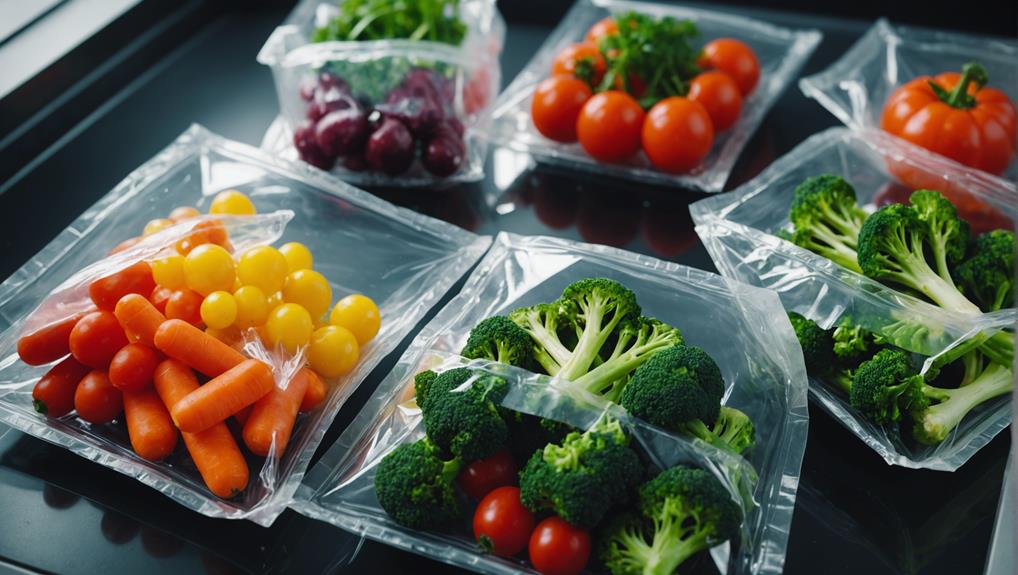
For ideal sous-vide cooking results, select meats like beef, lamb, and pork for enhanced tenderness and flavor. Sous-vide cooking involves sealing food in a bag and cooking it in a water bath at a precise temperature for an extended period. This method is particularly beneficial for meats as it helps maintain moisture and results in a tender texture that's difficult to achieve through traditional cooking methods.
When it comes to vegetables, options like carrots, asparagus, and potatoes are excellent choices for sous-vide cooking. By vacuum-sealing these vegetables and cooking them at controlled temperatures, you can preserve their nutrients, colors, and flavors more effectively compared to other cooking techniques.
Poultry, including chicken and turkey, also benefits greatly from sous-vide cooking. The gentle and consistent heat ensures that the meat remains juicy and tender throughout the cooking process.
Additionally, fish varieties like salmon, halibut, and cod can be perfectly cooked using the sous-vide method. This technique helps maintain the delicate texture and flavors of fish, resulting in a moist and flavorful dish.
Eggs are another versatile option for sous-vide cooking. By precisely controlling the temperature and cooking time, you can achieve eggs with various textures, from soft and creamy to firm and custard-like. Experimenting with different foods in sous-vide cooking can lead to delightful culinary experiences and nutritious meals that support your wellness goals.
Vegetable Preparation Techniques
Enhance the nutritional value and taste of vegetables through precise sous-vide cooking techniques that safeguard flavors, colors, and essential nutrients. When using sous-vide for vegetable preparation, you can uphold the natural goodness of these ingredients by cooking them at controlled temperatures for extended periods. This method guarantees that the vegetables retain their flavors, colors, and nutrients, resulting in vibrant, firm, and delicious outcomes.
To better understand the benefits of sous-vide vegetable preparation, let's explore the advantages in a comparative table:
| Traditional Cooking Methods | Sous-Vide Cooking |
|---|---|
| Loss of nutrients and colors | Preserves nutrients and colors |
| Inconsistent texture | Maintains even texture throughout |
| Variable cooking times | Precise and controlled cooking |
Sous-vide cooking stands out for its ability to enhance the texture, taste, and visual appeal of vegetables while keeping them nutrient-rich. By opting for sous-vide, you are selecting a method that ensures your vegetables are cooked to perfection, offering a delightful culinary experience that aligns with your wellness goals. So, the next time you prepare vegetables, consider the sous-vide technique for a flavorful and wholesome outcome.
Sous-Vide Seafood Recipes
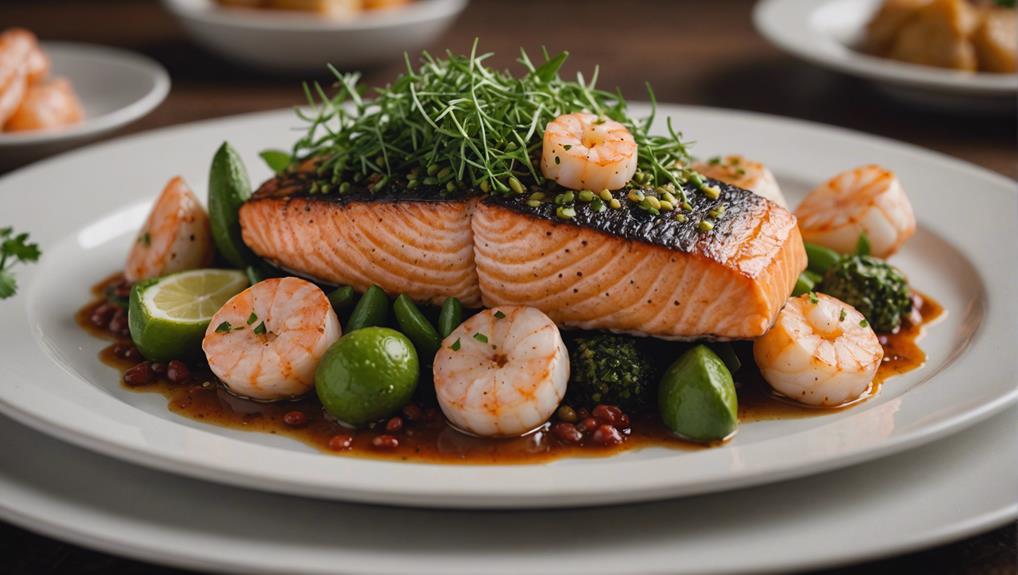
Sous-vide cooking elevates the culinary experience of seafood by preserving natural flavors, textures, and nutrients through precise temperature control in vacuum-sealed bags. This method involves cooking fish, shellfish, and other aquatic delicacies at specific temperatures, ensuring that the seafood retains its inherent qualities while enhancing tenderness and juiciness. The beauty of sous-vide lies in its ability to guarantee even heat distribution, resulting in perfectly cooked seafood every time.
Dive into the world of sous-vide seafood recipes by exploring dishes like salmon fillets, shrimp, lobster tails, and octopus. Each type of seafood requires different cooking times and temperatures, allowing for a versatile culinary experience. Whether you're a seasoned chef or a home cook, experimenting with various seasonings, herbs, and marinades can further elevate the flavors of your sous-vide seafood creations to suit your preferences.
Nutrient Retention in Sous-Vide
Retaining essential nutrients in food is greatly enhanced through the precise cooking method of sous-vide. This cooking technique excels in preserving the nutritional value of various vitamins and minerals, making it an excellent choice for those seeking to maximize the health benefits of their meals. Studies have shown that sous-vide cooking retains up to 90% of water-soluble vitamins like vitamin C, ensuring that your food remains packed with essential nutrients. Additionally, essential minerals such as iron and potassium are better preserved through sous-vide compared to traditional cooking methods. The low cooking temperatures in sous-vide play a crucial role in safeguarding delicate nutrients like antioxidants and phytonutrients, which are often compromised in other cooking styles.
To illustrate the nutrient retention benefits of sous-vide cooking, consider the following table:
| Nutrient Type | Preservation Rate |
|---|---|
| Water-Soluble Vitamins | Up to 90% |
| Essential Minerals | Superior to traditional methods |
| Antioxidants | Preserved due to low cooking temperatures |
Managing Meal Preparation Time

To optimize efficiency in meal preparation, incorporating sous-vide cooking techniques can greatly streamline the cooking process and alleviate last-minute meal prep stress. Sous-vide cooking reduces meal preparation time by allowing for batch cooking and easy reheating. This method enables you to pre-prepare meals in advance and store them, providing quick and convenient consumption options during busy days. The precise temperature control in sous-vide cooking guarantees consistent results, saving you time on monitoring and adjusting temperatures. By vacuum-sealing ingredients for sous-vide cooking, you can efficiently organize meal components for easy assembly, further enhancing time management in the kitchen.
Incorporating sous-vide cooking into your meal planning can revolutionize the way you approach cooking. With the ability to prepare meals ahead of time and store them for later use, you can enjoy the benefits of ready-to-eat, high-quality dishes without the stress of last-minute preparations. By embracing sous-vide techniques, you can streamline your cooking process, freeing up time for other activities while still maintaining a healthy and balanced diet. Take advantage of the time-saving benefits that sous-vide cooking offers to make meal preparation a seamless and enjoyable part of your wellness journey.
Lifestyle Integration Tips
For enhancing the integration of lifestyle tips into the Body for Life Diet, consider incorporating practical strategies that align with your wellness goals and daily routines. To seamlessly integrate the Body for Life Diet with sous-vide cooking into your lifestyle, start by planning your meals in advance. This proactive approach can help you stay on track with your nutrition goals while saving time during busy days. Preparing sous-vide meals in batches and storing them in portioned containers can streamline your eating habits, ensuring you have healthy options readily available.
Additionally, make use of technology to simplify your cooking process. Sous-vide machines often come with convenient features like WiFi connectivity or mobile apps that allow you to monitor your meals remotely. Embracing these technological advancements can make meal preparation more efficient and flexible, fitting into your lifestyle with ease.
Moreover, prioritize self-care and mindfulness when it comes to mealtime. Set aside dedicated moments to enjoy your sous-vide creations, savoring each bite mindfully. This practice not only enhances your dining experience but also promotes digestion and overall well-being.
Frequently Asked Questions
What Are the Disadvantages of Sous Vide Cooking?
When considering sous-vide cooking, remember potential drawbacks such as soft texture, lack of Maillard reaction, bacterial risks, extended cooking times, and equipment costs. Despite these, sous-vide can enhance flavors and nutrients, offering a unique culinary experience.
What Are the Side Effects of Sous Vide Cooking?
When considering the side effects of sous-vide cooking, it's important to note potential risks like bacterial contamination, texture changes in foods, botulism toxin risk, precise temperature control necessity, and concerns about chemical migration. Follow safe practices for best results.
How Healthy Is Sous Vide Cooking?
Sous-vide cooking is a healthy method that retains nutrients, reduces harmful compounds, and minimizes the need for added fats. By enhancing flavors without excessive salt or sugar, this technique supports nutritious eating habits, making it ideal for health-conscious individuals.
What Should Not Be Sous Vide?
When it comes to sous-vide cooking, certain foods like whole mushrooms, garlic, soft cheeses, lettuce, leafy greens, and fruits are not recommended due to safety or texture concerns. Delicate items, high-sugar foods, and those needing a crispy texture are also best avoided.
Conclusion
To sum up, incorporating sous-vide cooking into your Body for Life diet can truly revolutionize your wellness journey. By harnessing the benefits of precise temperature control and extended cooking times, you can elevate the flavor, tenderness, and nutritional excellence of your meals.
Say goodbye to bland dishes and hello to vibrant, delicious options that support your quest for a healthy lifestyle. With sous-vide, every bite becomes a step towards a healthier, more vibrant you. Start your transformation today!






